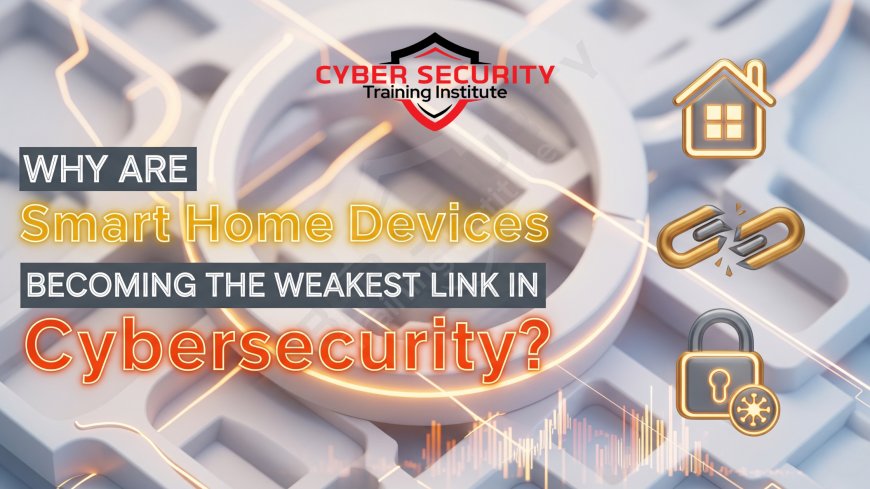Why Are Smart Home Devices Becoming the Weakest Link in Cybersecurity?
In 2025, the smart home has become the primary back door for cybercriminals. This in-depth article explains why the billions of convenient Internet of Things (IoT) devices in our homes are now the weakest link in our entire cybersecurity posture. We break down the core issues: the "insecure by design" practices of manufacturers who prioritize low cost over security, and the "set it and forget it" mindset of users who fail to change default passwords or apply updates. Discover how hackers are using a single compromised smart device, like a lightbulb or a toaster, as a "gateway" to pivot into our trusted home networks, attack our work laptops, and steal our most sensitive data. The piece features a comparative analysis that starkly contrasts the robust security of a modern PC or smartphone with the glaring vulnerabilities of a typical smart home device. We also provide a focused case study on the national security risk this creates for India, where the massive adoption of low-cost IoT devices is creating a potential nation-scale botnet. This is a must-read for every consumer and security professional who needs to understand the new, hidden dangers inside our connected homes and the steps we need to take to make our smart homes secure.

Introduction: The Unlocked Back Door
Our homes in 2025 are smarter than ever before. We have smart speakers that play our music, smart lights that change color with our mood, and smart cameras that let us check on our pets from halfway across the world. We've eagerly filled our homes with a new level of convenience and automation. But in doing so, we've also unknowingly opened dozens of new, unsecured back doors for cybercriminals. In the world of security, the "weakest link" is the easiest and most likely point of entry for an attacker. Smart home devices, also known as the Internet of Things (IoT), are rapidly becoming the weakest link in our entire digital lives. They've become the primary target because they are often built with poor security, are rarely managed or updated by their owners, and provide a perfect, undefended gateway for hackers to enter our home networks and launch much larger, more dangerous attacks.
"Insecure by Design": The Manufacturing Problem
The problem starts long before a device ever reaches your home. It starts with the manufacturer. The market for smart home devices is incredibly competitive, and many companies are in a race to the bottom, competing on price and flashy features, not on robust security. This often leads to a product that is "insecure by design."
Common security failures that are built-in from the factory include:
- Hardcoded or Default Passwords: This is the single biggest issue. Many cheaper devices ship with a simple, default administrative password (like "admin" or "password") that is the same for every single device they sell. Attackers have lists of these default passwords for thousands of devices and are constantly scanning the internet for them.
- No Secure Update Mechanism: To save on development costs, many manufacturers build their devices with no way to receive and apply security updates. This means that if a critical vulnerability is discovered in the device's software, there is no way to fix it. The device is permanently and forever vulnerable.
- Insecure Communication: A shocking number of smart devices transmit data over your home Wi-Fi network without any encryption. This means that if an attacker can get onto your network, they can easily "listen in" on what these devices are saying, which could include anything from your voice commands to the video feed from your security camera.
The result is that we are buying and installing millions of devices that are already vulnerable right out of the box.
The "Set It and Forget It" User Mindset
The second half of the problem is us, the consumers. We have a completely different mental model for a smart device than we do for a computer. We think of our laptop or our smartphone as a powerful computer that needs security software and regular updates to stay safe. We do not think of our smart lightbulb, our smart coffee maker, or our smart television in the same way. We treat them like simple appliances.
This "set it and forget it" mindset has serious security consequences. Most users will install a new smart device, get it working, and then never think about its security again. They almost never change the default password, and they will almost certainly never check the manufacturer's website for a firmware update, even if one is available. This creates a massive, global network of millions of "abandoned" but fully operational and internet-connected computers sitting inside our homes, just waiting for a hacker's automated scanner to find them. .
The Gateway Hack: From Your Smart Plug to Your Bank Account
You might wonder, "Why would a hacker care about my smart toaster?" The answer is that they don't care about your toaster. They care about your network. A compromised smart device is the perfect "foothold" for an attacker to get inside your home network, bypassing the security of your main internet router.
Once they have control of that one, single, insecure device, they can launch a variety of attacks against the other, much more valuable devices that are connected to the same "trusted" home Wi-Fi network. From your compromised smart plug, an attacker can:
- Eavesdrop on your network traffic to steal unencrypted passwords or sensitive information from other devices.
- Scan your network to find your work laptop and then launch attacks against it, hoping to pivot from your home network into your employer's secure corporate network.
- Use your device's internet connection as part of a massive botnet to launch DDoS attacks, send spam, or commit other crimes, all of which will be traced back to *your* home's IP address.
The insecure smart toaster becomes the unlocked back door that lets the burglar into your entire digital house.
Comparative Analysis: PC/Smartphone vs. Smart Home Device Security
The difference in the security posture between a modern computer and a typical smart home device is stark, highlighting exactly why IoT has become the weakest link.
| Security Feature | PC / Smartphone | Typical Smart Home (IoT) Device |
|---|---|---|
| Security Mindset | Users generally understand that these are powerful computers and are conscious of security risks, even if their practices aren't perfect. | Users see these as simple, single-function appliances and are often completely unconscious of the underlying security risks. |
| Password Policy | Forces the user to create a strong, unique password or passcode during the initial setup process. | Often ships with a weak, universal default password (like "admin") that it does not force the user to change. |
| Patching & Updates | Receives regular, often automatic, and mandatory security updates from the manufacturer (e.g., Windows Update, iOS Update). | Rarely receives updates. If updates are available, the process is often manual and almost universally ignored by the user. |
| Security Software | Runs sophisticated, multi-layered security software, including antivirus, Endpoint Detection and Response (EDR), and personal firewalls. | Has no built-in security software and no way for the user to install any. |
| Manufacturer Priority | Security is a major marketing point and a top priority for manufacturers like Apple, Google, and Microsoft, who have massive security teams. | Security is often an afterthought or is deliberately sacrificed by manufacturers who are prioritizing a low price and a fast time-to-market. |
The Risk in India: From Urban Homes to National Botnets
The adoption of smart home technology in India's cities, including Pune and Pimpri-Chinchwad, has absolutely exploded in 2025. Driven by the widespread availability of high-speed internet and falling device prices, millions of Indian homes are now filled with a diverse mix of smart devices from both reputable international brands and cheaper, unbranded manufacturers.
This rapid, often price-conscious adoption creates a massive national security vulnerability. Many of the lower-cost, unbranded devices that are popular in the Indian market are particularly egregious when it comes to security. They often have no security features whatsoever. This has allowed for the creation of a massive, distributed network of millions of vulnerable and compromisable devices sitting in homes all across India. A sophisticated adversary could easily compromise these devices to create a colossal, nation-scale botnet. This "Indian botnet" could then be weaponized to launch a devastating DDoS attack against the country's critical digital infrastructure, such as the UPI payment system, a major stock exchange, or key government websites. The weakest link in a single home in Pimpri-Chinchwad, when multiplied by millions, becomes a strategic threat to the entire nation.
Conclusion: Making the Smart Home a Secure Home
Smart home devices have become the weakest link in our cybersecurity chain for a simple and dangerous reason: they perfectly combine the vulnerabilities of an "insecure by design" manufacturing ethos with a "set it and forget it" user mindset. Each insecure device we install is a silent, unprotected, and permanently open back door into our most trusted digital space: our home network.
Solving this problem will require a major shift from both manufacturers and consumers. Manufacturers must be held to higher security standards, either by regulation or by consumer demand, and must be forced to build security into their products from the very first stage of design. And as users, we must evolve our own mindset. We have to start treating every single device that we connect to our network, no matter how small or trivial it seems, with the same security diligence as we would our primary computer. The incredible convenience of the smart home is here to stay, but to enjoy it safely, we must first focus on making it a secure home.
Frequently Asked Questions
What is a smart home device?
A smart home device, also known as an IoT (Internet of Things) device, is any non-traditional computing device in your home that connects to the internet to provide automation or remote control. Examples include smart speakers, smart lightbulbs, and smart security cameras.
What does "weakest link" mean in cybersecurity?
The "weakest link" is a principle that states that a security system is only as strong as its most vulnerable part. Attackers will always target the easiest point of entry.
What is a botnet?
A botnet is a network of thousands or millions of hijacked internet-connected devices that have been infected with malware and are controlled as a group by a single attacker, often to launch DDoS attacks.
What is a default password?
A default password is a simple, publicly known password that is set by the manufacturer for all devices of a certain model. It is critical that users change this password during setup.
Why is my smart TV a security risk?
A smart TV is a full-fledged computer that is connected to the internet. If it is not properly secured or updated, it can be compromised just like a PC, and could be used to spy on you or attack other devices on your network.
How can a hacker get from my smart plug to my laptop?
Once an attacker compromises a simple device like a smart plug, they are "inside" your home Wi-Fi network. From there, they can scan the network to find your other devices, like your work laptop, and then launch attacks against them that would have been blocked by your main internet router's firewall.
What is a firmware update?
Firmware is the low-level software that runs on a hardware device. A firmware update is a patch provided by the manufacturer to fix bugs or, most importantly, to patch security vulnerabilities.
Why is India's market particularly vulnerable?
Because the market has seen a massive and rapid adoption of smart devices, including many low-cost, unbranded devices that often have the worst security practices. This creates a very large pool of vulnerable devices for attackers to target.
What is the "Internet of Things" (IoT)?
IoT refers to the vast network of physical devices around the world that are now connected to the internet, all collecting and sharing data.
What is a DDoS attack?
A DDoS (Distributed Denial of Service) attack is an attempt to make an online service unavailable by overwhelming it with traffic from multiple sources, such as a large IoT botnet.
How do I know if my smart device is secure?
It's difficult, but a good rule of thumb is to buy from large, reputable brands that have a track record of providing security updates. Avoid no-name, cheap devices, and always check if you can change the default password.
What is a home network firewall?
The firewall is a security feature in your home's Wi-Fi router. It is designed to block unsolicited incoming connections from the internet, but it provides little protection against an attack that originates from an already-compromised device *inside* your network.
What is "pivoting" in a hack?
"Pivoting" is the technique an attacker uses to leverage a compromised machine to attack other, different machines on the same network. This is the primary risk of an insecure IoT device.
What is the most important thing I can do to secure my smart home?
The single most important thing is to go through every smart device you own, find its administrative settings, and change the default password to a long, strong, and unique one.
Should I put my smart devices on a separate Wi-Fi network?
Yes, this is an excellent security practice. Many modern routers allow you to create a "guest" network. Putting all of your less-secure IoT devices on this separate network can prevent an attacker who compromises one of them from being able to see or attack your more important devices, like your laptop or phone.
What does it mean for a device to be "insecure by design"?
It means that the manufacturer did not build fundamental security features into the product from the beginning. The product is vulnerable because of decisions made during its design and manufacturing process.
What is the UPI payment system?
The Unified Payments Interface (UPI) is an instant real-time payment system developed in India. It is a critical piece of national infrastructure that could be a target for a massive, nation-scale DDoS attack from a botnet of compromised Indian IoT devices.
What does it mean to "eavesdrop" on network traffic?
If the data from a device is not encrypted, an attacker who is on the same network can use tools (like a "packet sniffer") to intercept and read the data that the device is sending and receiving.
Why do manufacturers ship devices with default passwords?
They do it to make the initial setup process as simple as possible for the user. However, this convenience comes at a massive security cost.
What is the future of IoT security?
The future likely involves government regulation and security labeling standards (like an energy rating label, but for security) that will force manufacturers to build safer products and will allow consumers to make more informed choices.
What's Your Reaction?
 Like
0
Like
0
 Dislike
0
Dislike
0
 Love
0
Love
0
 Funny
0
Funny
0
 Angry
0
Angry
0
 Sad
0
Sad
0
 Wow
0
Wow
0















